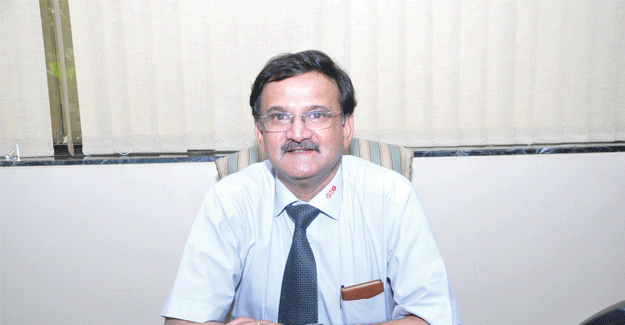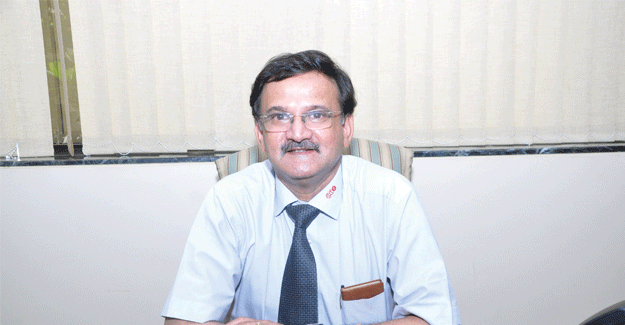
“I’m Bullish About Growth Of Indian Textile Sector”
The technological marvel that was envisioned way back in 1939, namely A.T.E., to combat the might of the British monopoly in the Indian textile sector with innovative German technology has come a long way in carving a niche for itself in textile technology besides diversifying its portfolios. Currently, A.T.E. has a grand reputation of being the leading textile engineering company in India. Needless to say, A.T.E. offers end-to-end technology solutions across the textile value chain.
A.T.E. Textile Engineering Group Director, Gurudas Aras airs his views on current trends in the textile industry, problems, challenges and also his group’s achievements in an exclusive interview with Venkatesh Raghavan, Special CorrespondentTextile Excellence recently at his office in Mumbai. Excerpts from the interview are reproduced below.
How is the current Investment scenario in the textile sector? We have noticed that the big ticket investments are missing and India is not investing to its potential.
I agree that right now the investment scenario is challenging. This is not without its reasons. Currently, the investment cycle in the textile sector is facing a downward phase. After the implementation of the GST system in last July, investments have taken a beating. The trouble lies with the risk-taking abilities of the companies and GST cannot be attributed as the sole factor in this downward trend. There have been a series of banking scams and defaults, the latest being the one in Punjab National Bank (PNB). Post the PNB fiasco, banks have been very cautious and loan approval or funding process for new projects has become extremely slow. This new order has shaken the faith of the investors too and investment in the textile sector has taken a beating.
Having said this, I should also point out that there are several projects under implementation in the textile sector. There are also several companies eying the prospects in the sector. However, all this is still in the artist’s easel. Most projects that investors wish to undertake are under review or at different stages of approval. Given the bureaucratic set up of this country, review takes its own sweet time. As of now, there is no clear picture as to how long it will take for the investment scenario to improve.
Which are the sectors, according to you that need more investment? Are the textile policies of various states providing enough impetus?
There is urgent requirement for upgrades to be effectuated in the processing and weaving sectors. Also, there is more demand for good quality yarn both in processing and weaving. In fact, processing sector is still lagging behind in technology and overall capacity that the country needs. Though A.T.E. plays an important role in processing, in the pan Indian scenario, quality processing work proves difficult.
Responding to the second part of your question, the state textile policies are very attractive. However, very few entrepreneurs are adequately responding to these state textile policies. So far, the scenarios in Telangana and Andhra Pradesh are good and competitive. These two states have laid out the infrastructure very well. They have a conducive environment for carrying out business. While some projects are under implementation, as I stated earlier, there are many projects on the table and are awaiting clearance.
How does A.T.E. help textile manufacturers to improve process efficiency and remain cost competitive?
Our main focus in offering value to our customers is on energy saving, labour cost saving and environmental sustainability besides improving efficiency. All machines supplied by A.T.E. to customers are highly energy efficient. Since we deal in textile machinery which is traditionally a high power consuming industry, we offer technology that optimizes the power consumption. We not only optimize electrical energy but also steam. We set up, maintain and service these machines as well.
A.T.E. also helps customers in a big way in effectuating automation and Internet of Things (IoT) solution. This helps in the performance of our client’s capital requirements. We help them improve the efficiency of their machinery and stay ahead of their competitors.
For example, old machines used in the textile industry are less productive. On the other hand, it’s very expensive to replace them. In such situations, we help them upgrade the machines hardware as well as deploy software enabling to achieve higher productivity and higher cost efficiency at much lower investment.
Our contribution to sustainability is also substantial. We have solutions that decrease water consumption considerably. We are also providing effluent and waste water treatment solutions that use state-of-the-art biological systems. We have made this technology so cost-effective that customers can adapt sustainable technology.
We have noticed that China has become the world’s largest textile machinery exporter recently. How do you see this? Do you think China made machines (even if it’s a European brand) would make more in roads into the Indian market?
I would say, this will not happen in the immediate future in India. It must be borne in mind that ever since Chinese manufacturers have come into the Indian markets, they have created a negative image in the country. Well, Indian customers opt to buy European brand names manufactured in China. The gap between European and Chinese technologies is bridging. However, Chinese technologies as a standalone supplier will have difficult prospect as they lack after sales service support unlike the European brands. This is the reason why Indian manufacturers are hesitant to buy Chinese machinery.
In a nutshell, China has to work hard on creating a positive image and build strong service network in India.
What are the reasons that India is still manufacturing commodity textile and not moving up to niche segment?
There is a marked unwillingness to break grounds in fresh pastures. Whenever a project proposal is put forth, entrepreneurs look for formulating a joint venture with a foreign manufacturer. They usually don’t think beyond their security cover mindset. Why should a foreign company think of a joint venture with you when they are capable of managing it on their own or why would a foreign investor create a competitor in the niche segment? The reasoning has to change. Entrepreneurs should venture into risk taking and assume responsibility for taking bold decisions. When such a mindset change happens, it will work wonders for the Indian textile industry.
How do you see Indian textile industry evolve from here in the next five years?
There is a lot of scope for potential investors to be bullish on the Indian textile industry. India is a big market. The young generation in India is highly fashion conscious and growing income would create demand for all types of textile and apparels in next five years.
However, we witness several bottlenecks. Our textile value chain is still fragmented. While raw cotton is produced in huge quantity in Maharashtra and Gujarat, the majority of the spinning mills are found to be in Tamil Nadu and fabric weaving is concentrated in central and northern India. Barring few pockets like Tirupur, Surat and to some extent Ahmedabad, in most instances India witnesses a fragmented textile value chain. The value leakage and cost of transportation renders the finished goods uncompetitive. Besides, we need to usher in greater transparency in our system to ensure that projects on anvil do not face unnecessary delay. Prime Minister Narendra Modi has streamlined the process to a great extent. However, the system being what it is, there is a need of a massive mindset change to become efficient, cost effective, environmentally conscious and innovative.

Textile Excellence
If you wish to Subscribe to Textile Excellence Print Edition, kindly fill in the below form and we shall get back to you with details.








